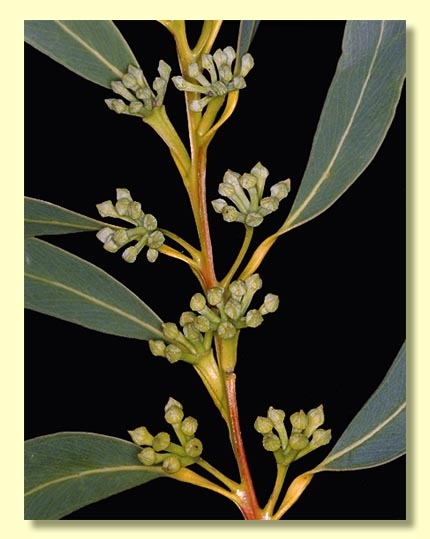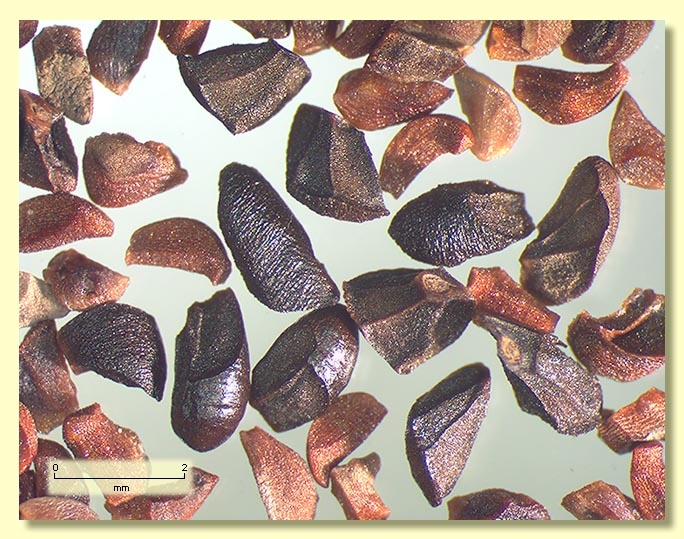Euclid - Online edition
Eucalyptus luehmanniana
Eucalyptus | Eucalyptus | Cineraceae | Fraxinales
Mallee to 7 m tall. Forming a lignotuber.
Bark smooth, shedding in strips, white to yellowish or brown, grey or olive.
Branchlets always prominently square in cross-section, usually yellow but sometimes glaucous.
Juvenile growth (coppice or field seedlings to 50 cm): stems usually square in cross-section; juvenile leaves opposite and sessile or subsessile for 3 or 4 pairs, elliptical, then petiolate, alternate, broadly lanceolate, 7–17.5 cm long, 3–7.5 cm wide, bases becoming oblique, glossy, green.
Adult leaves alternate, petiole 1.7–4 cm long; blade lanceolate to falcate, 10–20 cm long, 2–4.5 cm wide, base usually oblique, concolorous, glossy, green, side-veins acute, sparsely to moderately reticulate, intramarginal vein parallel to and well removed from margin (occasionally doubled), oil glands island.
Inflorescence axillary unbranched, peduncle broadly flattened, 1.5–2.5 cm long, buds 11-?15 per umbel, pedicels 0.3–1.1 cm long. Mature buds clavate to diamond-shaped, 0.6–1 cm long, 0.4–0.7 cm wide, yellow, sometimes glaucous, with hypanthium slightly ribbed longitudinally, scar absent, operculum beaked to conical to pyramidal, stamens irregularly flexed, anthers reniform to cordate, versatile, dorsifixed, dehiscing by confluent slits, style long, stigma tapered, locules 5 each with 2 vertical ovule rows. Flowers white.
Fruit pedicellate (pedicels 0.2–1 cm long), cup-shaped, urceolate or barrel-shaped, 0.8–1.3 cm long, 0.9–1.2 cm wide, slightly ribbed longitudinally, glaucous or non-glaucous, disc raised and slightly convex or level to descending, valves 5, near rim level or enclosed.
Seeds dark brown, black or grey, 2–3 mm long, pyramidal or obliquely pyramidal, dorsal surface smooth, hilum terminal.
Cultivated seedlings (measured at ca node 10): cotyledons reniform; stems square in cross-section, slightly glaucous or non-glaucous; leaves sessile to shortly petiolate, elliptic and opposite for few pairs then alternate, ovate-lanceolate, 7–14 cm long, 4–7 cm wide, base truncate to tapering, margin entire, apex pointed, dull, grey to blue-grey.
Flowering has been recorded in June, July, August, September, October, November and December.
A large mallee of restricted distribution on sandstone around Sydney, New South Wales.
E. luehmanniana belongs to the blue-leaved ashes but resembles no other species in the group, being distinguished by its mallee habit, glaucous to yellow, angular branchlets, thick, glossy green leaves, flattened peduncles and coarse, yellow or glaucous buds and thick-rimmed fruits. It may resemble E. langleyi from south-west of Nowra but this species is less coarse and not as yellowish nor as glaucous as E. luehmanniana.
Populations of E. luehmanniana vary in the presence or absence of glaucescence, or white wax, on branchlets and buds. Plants in Heathcote and Royal National Parks in the south of the species range are conspicuously glaucous whilst those to the north in the Tumbledown Dick – Ku-ring-ai Chase area are only slightly glaucous or non-glaucous. Further to the north the population on Mt Kariong is again quite glaucous and, interestingly, has relatively small fruit. glaucescence is a highly variable character in the eucalypts and the differences seen here do not warrant taxonomic distinction.
Eucalyptus luehmanniana belongs in subgenus Eucalyptus section Cineraceae series Fraxinales having the following characters: cotyledons reniform, juvenile leaves alternate, bluish to glaucous, adult leaves with acute side-veins, single axillary inflorescences with buds in clusters of ca 11, buds with single operculum, irregularly flexed stamens with reniform anthers, ovules in two rows, and seeds more or less pyramidal.
The closest relatives are three tree species: E. fraxinoides, which has compact rough bark on the trunk; E. delegatensis, with its stocking of finely fibrous rough bark and brown seed; and E. oreades , with its short stocking of rough bark shedding in very coarse ribbons. Together these four species make up series Fraxinales.














